Motorsports Racing News & Blog Articles
Church of MO: 1997 Middleweight Cruiser Shootout
A quarter-century ago, we all squinted a lot since the world was so lo-res, pixellated and buzzy. Harley’s 883 Sportster was still the best-selling motorcycle in the US – $5,345 with laced spoke wheels – and all the other players badly wanted a piece of that middleweight cruiser action. Only one of them could beat the 883, though, and it wasn’t the Suzuki. Sad. But kinda fun in a dull, processional sort of way.
Cruise Light!

A middleweight cruiser is somewhat of an oxymoron. How to achieve that hefty cruiser feel, yet downsize the weight, displacement, and more importantly, price? To explore this enigma we gathered five of the finest little big bikes available: existing iron like Harley-Davidson’s 883 Sportster, Kawasaki’s Vulcan 800 Classic and Yamaha’s Virago 750, along with Honda’s all-new American Classic Edition 750 and Suzuki’s new Marauder 800. Each one has its own answer to the middleweight dilemma.
Speaking of dilemmas, what the heck do you do to properly compare cruisers for a shootout? You can’t just call up a racetrack and say, “Put us down for Tuesday, we’re bringing up a bunch of cruisers to test!” They’d laugh us right off the phone. And when we called up our resident fast-guys Shawn Higbee and Chuck Graves to see if they wanted to help evaluate the assembled equipment, through barely stifled yawns they told us that they, um, oh yeah, they had to wash their dogs today. Clearly it takes a slightly more laid-back attitude toward life to truly appreciate the cruiser. So we decided to do the typical cruiser thing — we followed the crowds. We motored up and down one of the world’s most popular boulevards, the Pacific Coast Highway in Malibu, along with a mandatory jaunt up through the canyons to the Rock Store. We rode around town, down long stretches of freeway, and even took them on a several hundred mile trip. All the while looking for that perfect nothing, the transcendence from the physical, the ultimate vibe, and all that other metaphysical stuff.
So kick back, relax, and throw back a cold one. This time we’ll do all the riding.
 |
 Marauder fuel tank comes complete with distinctive logo and cool racing-style filler. Marauder fuel tank comes complete with distinctive logo and cool racing-style filler.
|
 While handling was decent, ground clearance was a touch shy. While handling was decent, ground clearance was a touch shy.
|
1997 Suzuki Marauder 800
With much hoopla and fanfare Suzuki introduced four new models for their ’97 model year — GSX-R600, 1200 Bandit, TL1000 and the Marauder 800. Suzuki’s Marauder screams winner with its inverted forks, gobs of chrome, an 800cc motor, and, best of all, a $6000 price tag. It seems you could have it all.With motorcycles, as with life, things are not all that they seem. While it’s true that the Marauder boasts some very cool features, its total package is in need of further refinement.
The Marauder is based loosely on Suzuki’s Intruder 800, albeit with some important differences such as a switch to chain drive over the Intruder’s shaft, for smoother power delivery. While switching to a chain Suzuki also made room
for a fifth gear (the old Intruder having a four-speed box). They equipped the Marauder with an inverted front end, presumably for a beefy appearance, but these forks are really not much better than any of our other bikes in this test. Most of the other differences between this model and the Intruder are cosmetic, and we approve. Its long, lean look is a welcome replacement for the slightly-dated chopper look of the Intruder. Mag wheels and miles of chrome mean lots of shine on the boulevard, as the Marauder exudes a style all its own. The Suzuki is Japanese and proud of it. Like Honda’s ACE, it pays homage to the American original without plagiarizing. In fact it was second only to the Honda in the number of compliments it received.If only it was any fun to ride.
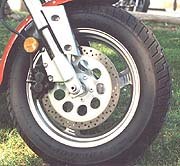 Mag wheels and upside-down forks make Marauder’s front end stand out.
Mag wheels and upside-down forks make Marauder’s front end stand out.
Starting with a wedge-shaped seat that begins to irritate in under five minutes and ending with the worst carburation of any bike we’ve recently tested, riding the Marauder is a bit of a trial. Its ergonomics are all wrong for a rider of even average size, with the drag-style bars too pulled back and the pegs not quite far enough forward. If you’re tall, forget it. The flat, riserless handlebars gave poor feedback and lousy control when traveling down twisty roads. Ground clearance is a bit on the meager side too, although not as limiting as the Vulcan. Have we mentioned the seat sucks?

A quick twist of the throttle and you can tell this beast has nuts. Then you hit that stumble. You figure you can gas your way through it, but by the time it clears up you’re already at the end of its powerband. What could be the best engine in this test is castrated by poor carburetion. Any first year engineering student could tell you that exhaust pipes of vastly different lengths are a tuner’s nightmare, and such is the case with Suzuki’s Marauder. Its left pipe wraps all the way over to the right to give an appearance of staggered dual pipes. Probably not helping any of this is the fact that its exhaust crossover tube is about one inch in diameter, bound to wreak all kinds of havoc with exhaust throughout.

What we’re telling you is that with a little tinkering (new seat, bars, control extenders, pipes and a jet kit) this could be a nice motorcycle. However, this being the Marauder’s first year in production, aftermarket support is not yet in existence, so it may be a while until you can upgrade this machine. If you’ve fallen in love with the Maurader’s looks, try waiting around outside your Suzuki dealer for someone to trade one in — we don’t think you’ll have to wait long.
Specifications
Manufacturer: Suzuki Model: 1997 VZ800V Marauder Price: $5,999 Engine: OHC, liquid cooled v-twin Bore and Stroke: 83 x 74.4mm Displacement: 805cc Carburetion: Dual Mikuni 36mm CV Transmission: 5-speed, constant mesh Wheelbase: 64.8 In. Seat Height: 27.6 in. Fuel Capacity: 3.4 gal. Claimed Dry Weight: 456 lbs.

1997 Yamaha Virago 750

Yamaha caught on early, even before the advent of supersport bikes, that a sizeable percentage of people just want to kick back and ride. Behold the Virago 750. Functionally, it does everything a cruiser should. It’s torquey, it stops well and it’s mostly unobtrusive on a long ride.During our ride up the coast the Virago got off to a good start, its torquey motor allowing gratuitous short-shifting, thus staying shy of its 5,000 rpm vibration point. Its ergos are relaxed, with the new, odd-looking flattened handlebars giving better comfort than the dreaded buckhorns. Taking a turn up the canyons, we found the Virago not to be a disappointment. Having second best ground clearance certainly helped in the fun. However, the Virago, like Suzuki’s Marauder, has footpegs that are just a bit too short for comfort. On both machines the first thing to touch the ground in a tight turn is likely to be your boot. The Virago’s shaft effect intruded upon the smooth roll of the terrain more than our other bikes (the rest being either chain or belt-driven), but never more than just a little. Altogether, it was solidly in the middle of the pack here, with Honda’s ACE better at the slow stuff and Harley’s Sportster superior during fast riding.
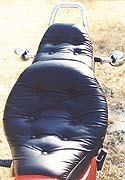 Virago’s saddle is spacious, but squishy.
Virago’s saddle is spacious, but squishy.
Out on the open road too, the Yamaha is certainly capable, but it’s not a stunner. While miles ahead of the Marauder and Sportster comfort-wise, it trails the ACE and Vulcan in plushness. While it has the most raw horsepower (claimed) in this test, it vibrates. At speed, the vibration of its rigidly mounted motor becomes intrusive. The seat, while soft, is a bit too mushy, causing the rider to settle into one position and stay there. You sit low in the frame, giving you the advantage of having the tank protect you from windblast. The sloped pillion is good for passengers, but it tends to irritate the driver as passengers will tend to slide forward a bit.
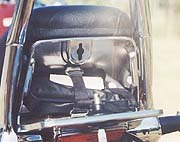 Yamaha equipped the Virago with a smallish-but-handy locking tool box mounted behind the passenger pad.
Yamaha equipped the Virago with a smallish-but-handy locking tool box mounted behind the passenger pad.
Don’t let the seat or any other silly tidbits get under your skin, though. After 17 years of production, and almost no with updates for the last nine, Yamaha’s Virago has developed tremendous aftermarket support. With our $8000 target price in mind, its $6499 sticker leaves you with $1501 dollars to spend on the finer things. Still, despite the relatively light purchase tag, it came in as the second most pricey unit in this test.If only it weren’t so ugly.
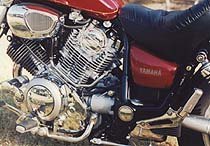 Lumpy look of Virago’s powerful engine didn’t appeal.
Lumpy look of Virago’s powerful engine didn’t appeal.
With the idea of cruisers being more about form than function, the Yamaha plummeted to fourth in our comparison, besting only the Marauder. Call us vain, call us fashion victims, whatever, but try not to point and stare while we ride the Virago 750, like so many others did. From its bulbous chrome extremities sticking out at all angles, to the squished buckhorn-style handlebars, Yamaha’s Virago series is aesthetically challenged. Editor Plummer was our lone defender of the Virago 750, saying it “would have looked better in black.”
 Virago’s traditionally-styled cockpit. (Note trez cool black wire ties)
Virago’s traditionally-styled cockpit. (Note trez cool black wire ties)
While many other modern motorcycles may have been influenced by the fifties and sixties, Yamaha’s Virago 750 is born, bred and remains solidly planted in the 1980s. Perhaps someday the ’80s will return, values of the Virago will skyrocket, Virago knockoffs will appear from other Japanese manufacturers and Yamaha will have a hard time filling demand for this very capable bike. We’re just not going to hold our breath.Specifications:
Manufacturer: Yamaha
Model: 1997 Virago 750
Price: $6,499
Engine: OHC, air-cooled v-twin
Bore and Stroke: 83 x 69.2mm
Displacement: 749cc
Carburetion: Dual 40mm Mikuni
Transmission: 5-speed
Wheelbase: 60 in.
Seat Height: 28.1 in.
Fuel Capacity: na
Claimed Dry Weight: 483 lbs.
1997 Kawasaki Vulcan 800 Classic
 |
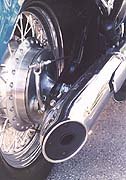 All the bikes finished in exactly the same order in our voting as to how we rated their exhaust note. Coincidence? All the bikes finished in exactly the same order in our voting as to how we rated their exhaust note. Coincidence?
|
“All the logos can be taken right off.”This was whispered to us as we picked up the beautiful Vulcan 800 Classic from Kawasaki, after they explained to us this is what their customers were looking for in a cruiser. Judging by its styling, with a tank badge and air cleaner right out of an H-D parts book, it looks like Kawasaki’s customers just didn’t like the idea of being on a three-year waiting list while paying twice as much.In all fairness, the Vulcan’s suspension and handling manners (other than ground clearance) were second only to the Sportster. And its killer fit and finish were runner up only to the ACE. Of course, pound for pound nobody makes an engine like Kawasaki. Around town and on freeway commutes the Vulcan is entirely transparent, meaning very little thought must be redirected into riding the motorcycle. Its wide, comfortable bars give good leverage when styling around at low speeds down the boulevard, while the wide, flat seat pleasantly supported one’s ever-widening posterior.
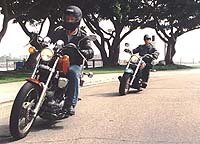 Although behind Yamaha’s Virago in outright horsepower, the Vulcan’s power delivery was much smoother.
Although behind Yamaha’s Virago in outright horsepower, the Vulcan’s power delivery was much smoother.
And to Kawasaki’s credit, it’s actually a good thing the suspension is just about spot-on from the factory, as the Vulcan’s shock is deviously hard to adjust, actually requiring removal of the rear wheel.Cruising up Pacific Coast Highway with the wind at your face, Kawasaki’s Vulcan 800 is right at home. Purring its music softly on the ocean breeze, the torquey motor prods you slowly towards paradise. Take a turn onto a slightly twisty road though, and a small design flaw becomes immediately apparent — no ground clearance. A small caution for the unwary: you will grind through the sidestand retaining spring before you get through the feelers on the pegs. This is not a case of sportbike weenines let loose on cruisers — the Vulcan 800 drags even at a relaxed pace.

During freeway cruising, its high bars gave a bit of the “parachute effect,” causing one’s jacket to puff-up and catch a bunch of wind. Turning the bars down a bit may cure this if lots of highway riding is your thing.
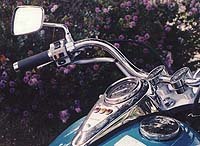 Vulcan’s cockpit is cleanly styled.
Vulcan’s cockpit is cleanly styled.
When all was said and done, the Vulcan 800 Classic actually turned out to be a really good motorcycle. Our testers all agreed it was a rock solid mount — comfy, torquey, fun and laid back. Our only real mechanical complaint was its lack of ground clearance. But we did all agree on one other point: lack of character. Kawasaki’s Vulcan 800 Classic is a motorcycle in search of its own identity. After a year on the market there is reasonable aftermarket support; however, being priced right at our pre-set $8000 spending limit (the most expensive in this test by a whopping $1500), you won’t have much spending money left after purchasing this one.
Specifications:
Manufacturer: Kawasaki Model: 1997 Vulcan 800 Classic Price: $7999 Engine: OHC, 8-valve, liquid-cooled v-twin Bore and Stroke: 88 by 66.2mm Displacement: 805cc Carburetion: Keihin CVK36 Transmission: 5-speed Wheelbase: 63 in. Seat Height: 27.8 in. Fuel Capacity: 4 gal. Claimed Dry Weight: 517 lbs.The post Church of MO: 1997 Middleweight Cruiser Shootout appeared first on Motorcycle.com.
Copyright
© Motorcycle.com

